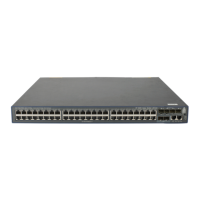124
• Area ID—Has a length of 1 to 13 bytes.
• System ID—A system ID uniquely identifies a host or router in the area and has a fixed length of 6
bytes.
• SEL—Has a value of 0 and a fixed length of 1 byte.
For example, for a NET ab.cdef.1234.5678.9abc.00, the area ID is ab.cdef, the system ID is
1234.5678.9abc, and the SEL is 00.
Typically, a router only needs one NET, but it can have a maximum of three NETs for smooth area
merging and partitioning. When you configure multiple NETs, make sure the system IDs are the same.
IS-IS area
IS-IS has a 2-level hierarchy to support large-scale networks. A large-scale routing domain is divided into
multiple areas. Typically, a Level-1 router is deployed within an area, a Level-2 router is deployed
between areas, and a Level-1-2 router is deployed between Level-1 and Level-2 routers.
Level-1 and Level-2
• Level-1 router—A Level-1 router establishes neighbor relationships with Level-1 and Level-1-2 routers
in the same area. It maintains an LSDB comprising intra-area routing information. A Level-1 router
forwards packets destined for external areas to the nearest Level-1-2 router. Level-1 routers in different
areas cannot establish neighbor relationships.
• Level-2 router—A Level-2 router establishes neighbor relationships with Level-2 and Level-1-2 routers
in the same area or in different areas. It maintains a Level-2 LSDB containing inter-area routing
information. All the Level-2 and Level-1-2 routers must be contiguous to form the backbone of the IS-IS
routing domain. Level-2 routers can establish neighbor relationships even if they are in different
areas.
• Level-1-2 router—A router with both Level-1 and Level-2 router functions is a Level-1-2 router. It can
establish Level-1 neighbor relationships with Level-1 and Level-1-2 routers in the same area, and
establish Level-2 neighbor relationships with Level-2 and Level-1-2 routers in different areas. A Level-1
router can reach other areas only through a Level-1-2 router. The Level-1-2 router maintains two LSDBs,
a Level-1 LSDB for intra-area routing and a Level-2 LSDB for inter-area routing.
Figure 33 sho
ws one IS-IS network topology. Area 1 is the backbone that comprises a set of Level-2
routers. The other four areas are non-backbone areas connected to the backbone through Level-1-2
routers.

